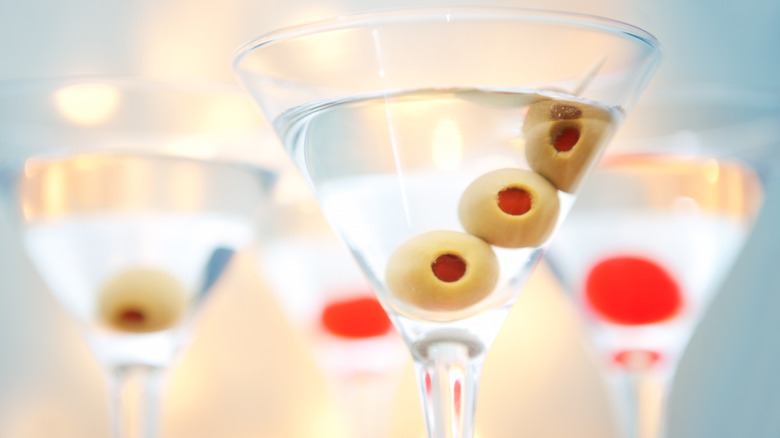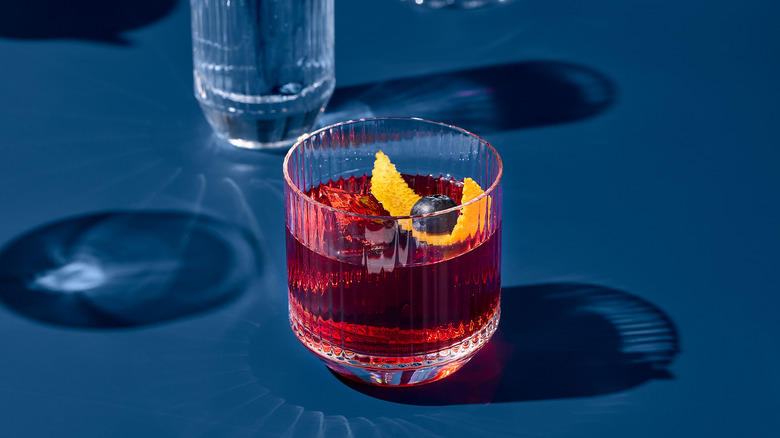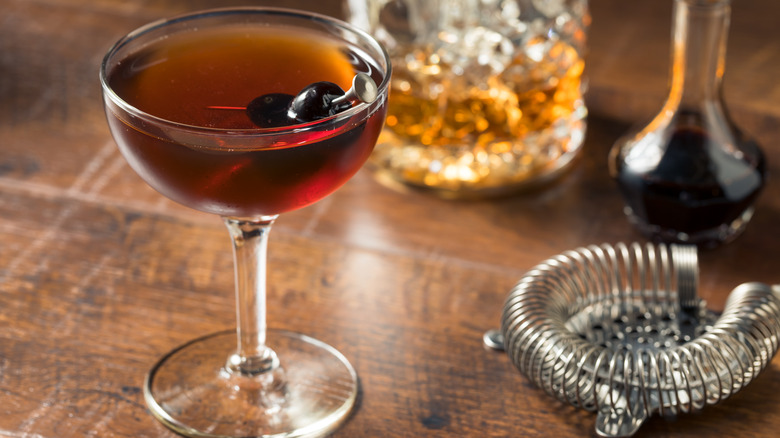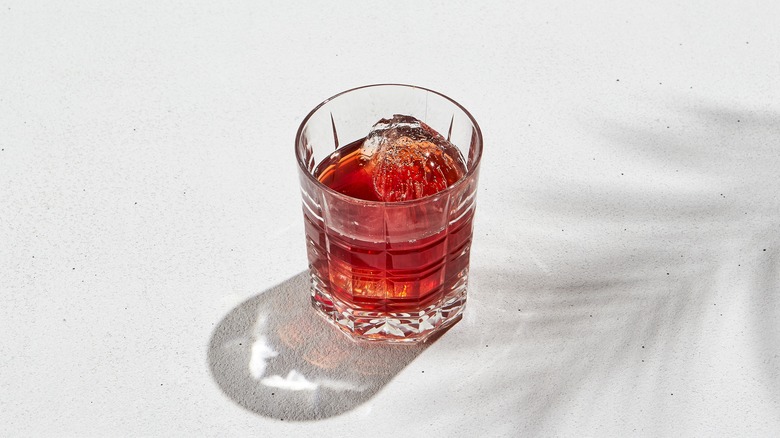There's More To Vermouth Than Dry Vs Sweet. A Mixologist Explains The Styles You Need To Know
If you drink alcohol, then you've likely heard of vermouth — after all, it plays a key part in some of the most popular cocktails, such as martinis and Manhattans — but you may not know much about it besides that. For anyone unfamiliar, vermouth is a fortified wine, which means that a distilled alcohol is added to both stop the fermentation process and increase the alcohol content. It becomes vermouth specifically when botanicals are added to it, making it aromatized as well as fortified.
Those who know the general basis of what vermouth is probably know that there are both dry and sweet versions. While this is true, there's actually a lot more to vermouth than just dry versus sweet — in fact, there are seven total styles of vermouth: dry, extra dry, white, amber, rosé, sweet, and chinato. To understand the differences and nuances between each of these styles, Tasting Table spoke to an expert: Francesco Lafranconi, the master mixologist at the Rosevale Cocktail Room, which is located inside the Civilian Hotel in New York City.
Extra dry and dry are the most common vermouth types for martinis
Extra dry vermouth is, unsurprisingly, the most dry of the seven types of vermouth. Fittingly, its sugar content is the lowest of the bunch at less than 30 grams per liter. It is the type of vermouth that's most likely used for a dry martini with a lemon peel garnish. Lafranconi explains, "It displays a subtle oxidative taste with wormwood bitter-finish. The aroma and taste offer citrus and savory elements, including a gentle whiff of baking spices."
The dry variation of vermouth is ever so slightly more sweet, with a sugar content of less than 50 grams per liter. Lafranconi compares it to a Fino-style sherry — while sherry is often on the much sweeter side (and considered a dessert wine), Fino is the driest type of sherry. Describing its qualities, Lafranconi called it, "Refined, savory-citrus with a balanced acidity, crisp and very pleasant." Dry vermouth may also be used for a martini.
If you're going to enjoy either extra dry or dry vermouth outside of a martini, Lafranconi says it should be enjoyed chilled. In fact, Lafranconi even advocates for sipping dry or extra dry vermouth on its own, declaring, "There is a pleasurable and unique sensory experience when considering extra dry and dry to be enjoyed like Fino-style sherry."
White vermouth is sweet but not too sweet
According to Lafranconi, white vermouth — also known as bianco vermouth — radiates elegance, due in part to its pale color, which he describes as "straw-like." As for the taste, Lafranconi says, "White vermouth has a sweet and delicate aromatic-savory profile ... Very enjoyable as an apéritif when served over ice or with tonic water." Its sweetness level is also a bit higher than that of dry or extra dry vermouth, with a sugar content of more than 130 grams per liter.
When it comes to serving white vermouth, Lafranconi explains that it is typically served over ice with a slice of lemon or lemon peel, "But grapefruit peel is also starting to appear as an alternative." As Lafranconi mentioned, you can also mix in tonic water, which will dilute the strength of the alcohol a bit while still allowing you to experience its complexity. White vermouth can also be used in cocktails, especially if you're looking for an element that is sweet but not overpoweringly sweet. For example, it's sometimes used in the El Presidente cocktail.
Amber vermouth is defined by its complexity
Like white vermouth, amber vermouth has a sugar content of over 130 grams per liter. Despite the similarities in sweetness level, the two taste quite different from one another. Lafranconi says, "This style of vermouth offers a more complex sensory experience than the standard white vermouth." Specifically, it takes the elegant nature of the white vermouth up a notch. Lafranconi continues, "As you take your first sip, the sweetness unfolds with a velvety texture, offering a savory and luxurious sensation."
Amber vermouth may be more complex and have a different mouthfeel than its white counterpart, but the two are often served the same way: over ice with a lemon peel, lemon slice, or grapefruit peel added to the glass. Again, your desired amount of tonic water can be added into the mix. It may also show up in cocktail recipes — for example, it is sometimes used in the alpine negroni in place of dry vermouth.
Rosé vermouth is a fun before-dinner drink
Rosé vermouth may just be the prettiest vermouth to look at thanks to its glittery, raspberry pink hue. Also sitting at over 130 grams of sugar per liter, Lafranconi describes it as plenty sweet and easy to drink. As for the specifics, Lafranconi says that it "provides a very pleasant and fresh aroma with notes of citrus, berries, florals, and spices."
Lafranconi suggests enjoying rosé vermouth as an apéritif (a drink served before a meal to stimulate the appetite). Like white and amber vermouth, rosé works well served over ice or with tonic water, but it also pairs well with lemonade. For a garnish, reach for grapefruit or berries. Rosé also works just as well in cocktails and can bring a vibrant, aesthetically pleasing visual to the drink. A couple of cocktails you might find rosé vermouth in include a rosé Collins or a rosé martini, the latter of which is perfect for anyone who wishes the classic martini was just a bit sweeter.
Sweet vermouth is more than just sweet
Sweet vermouth is usually made from white wines, although red sweet vermouth is not entirely unheard of. It is, of course, going to have a sweetness to it, but its flavors are actually much more complex than simply "sweet." Describing it as both lingering and enveloping, Lafranconi says, "Burnt sugar or caramel are used to provide the darker tones from amber to pomegranate molasses-like colors. Complex blend of bitter, sweet and spiced flavors." As for its sugar content, sweet vermouth is similar to the last few variations with over 130 grams of sugar per liter.
To enjoy sweet vermouth all on its own, Lafranconi suggests serving it chilled or over ice garnished with a slice of orange. Of course, it also shows up in a number of popular cocktails: Manhattans, negronis, Americanos, and boulevardiers all use sweet vermouth, just to name a few.
Chinato vermouth has a unique complexity
Lafranconi explains that chinato vermouth, which originated in Italy, is unique from the other vermouth types. He says, "What sets vermouth chinato apart from other vermouths is the addition of cinchona bark (quinine), which gives it a unique intriguing, complex, [and] enjoyable bitter-sweet experience." Like many of the other vermouths, its sugar content sits at over 130 grams per liter.
When it comes to the specifics of how to enjoy chinato vermouth, Lafranconi explains that it is the only one that should not be served chilled or over ice. Instead, drink chinato vermouth neat, either with or without an orange peel for a garnish. Like the other types, chinato vermouth can also be used in cocktails, although it may be less common. Some examples that use chinato vermouth as a key ingredient include the chinato nail, the dark side cocktail, and the Piedmont negroni.






